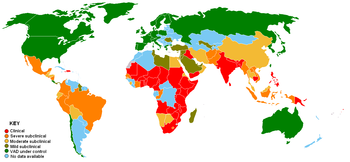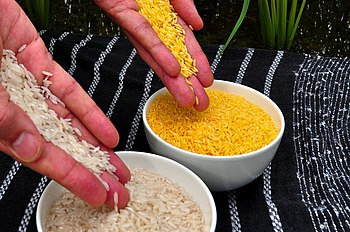You people in the developed world are certainly free to debate the merits of genetically modified foods, but can we please eat first?” - Dr. Florence WambuguThe blind girl lurched toward me across the parking lot at Tirta Empul temple, mewling. I guessed she was ten to thirteen years of age, and shorter than she should have been. A whitish haze coated her eyes, each looking upward in a different direction. She moved herky-jerky due to poorly formed bones. I did not speak Indonesian; she did not speak English, yet there was no doubt what she wanted. Money.
I gave her what I had in my pocket: a 5000 Rupiah note, about 42 cents.
She would buy rice with the little money I gave her. The food would fill her belly, but not her body’s needs.
Her condition is common for the poorest children in Asia; it is caused by a lack of Retinol (vitamin A). Retinol is a chemical (C20H30O) essential for healthy growth and vision. Most of us get enough vitamin A by eating a varied diet that includes yellow or green vegetables, though it is found also in cod liver oil and egg yolks. The poorest of the poor can afford to buy only rice, the cheapest food available. Rice has no vitamin A or beta-carotene, which our bodies convert to vitamin A. Chronic Vitamin A deficiency (VAD) causes irreversible blindness and poorly formed bones.

Prevalence of vitamin A deficiency from WHO data. Photocredit: Petaholmes.
Half of the afflicted will die within one year. VAD is also a major cause in high rates of maternal mortality during pregnancy and childbirth.
I encountered the girl in November, 2013, when my wife and I had arrived in Bali, Indonesia for my son’s wedding. Our clothes clung to us. The temperature was in the 80s with humidity to match. The heat index was 104.The “developing” in “developing country” is evident in Indonesia. People work hard and make very little. Indonesia’s GDP (Gross Domestic Product) per person is $ 4,923 per person per year; compare that with $51,704 for the United States.
The poorest of the poor can afford only rice to eat.
I saw rice fields everywhere I went. It seemed that any open field had rice planted on it. I watched Balinese men and women cut the rice stalks with a sickle and threshed the grain by hitting it against a screen into a container. Everything in the rice field seemed done by hand in the open sun. The people growing the rice can afford little more to eat than the rice they grow. And the rice they grow has no Retinol.
Each year around the world, one half-million are afflicted with irreversible blindness caused by vitamin A deficiency, just like the girl I saw at the Hindu temple.
If only there were a way that the rice could help prevent vitamin A deficiency.
There is: Golden Rice, a genetically modified food. It was developed in the late 1990s by Ingo Potrykus of the Institute of Plant Sciences in Switzerland and Peter Beyer, professor for cell biology at Freiburg University in Germany. They borrowed a gene from corn and one gene from a bacterium (remember bacteria make up ninety percent of our bodies). One bowl of golden rice supplies 60 percent of the daily requirement of vitamin A. It may not be a silver bullet, but something that can save nearly 500,000 children each year from blindness and eventual death strikes me as a miracle.
“Let's make the choices available to the people who have to take the consequences” - Per Pinstrup-Andersen of the International Food Policy Research InstituteYou may not like the idea of genetically modified food, but you probably do not have to watch your child die due to a lack of vitamins. Neither you nor I have the right to deprive someone of food that can literally save his or her life. “Let's make the choices available to the people who have to take the consequences,” Per Pinstrup-Andersen of the International Food Policy Research Institute told a group of congresspeople. Or as Dr. Florence Wambugu of Kenya puts it, “You people in the developed world are certainly free to debate the merits of genetically modified foods, but can we please eat first?”
If only those farmers I watched toiling under a brutal sun could be harvesting golden rice. Once countries such as Indonesia give their approval for golden rice, they can. It will be given to subsistence farmers without charge or restriction to grow. That will not save the little girl who confronted me in the temple parking lot, but it might save her sister.
Visit www.goldenrice.org for more information on Golden Rice.

Golden Rice grain compared to white grained rice.
Photo credit: International Rice Research Institute (IRRI)





Comments